Marino Marini
(Pistoia 1901 - 1980 Viareggio)
"Giocoliere"
(Jongleur)
Tusche, Feder und Aquarell auf mit Weiß grundierter Unterlage 1951
60,5 x 42 cm
sign. dat.
[21338]
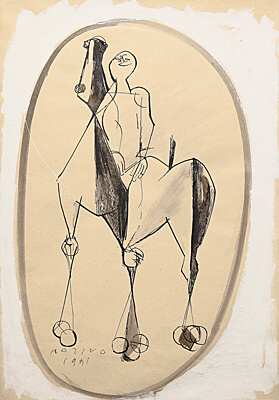
Marino Marini
(Pistoia 1901 - 1980 Viareggio)
"Giocoliere"
(Jongleur)
Tusche, Feder und Aquarell auf mit Weiß grundierter Unterlage 1951
60,5 x 42 cm
sign. dat.
[21338]
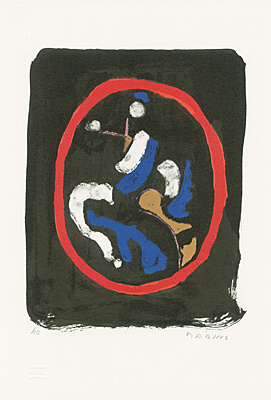
Marino Marini
(Pistoia 1901 - 1980 Viareggio)
"Composizione"
in "Marino Marini Druckgraphik" (Werkkatalog)
Buch mit 1 lose einliegenden Farblithographie 1975
31 x 20,6 cm, Abb. 21 x 16,5 cm
sign. bez.
Auflage ca. 60 Exemplare
Guastalla 7 (Seite 227)
[23449]
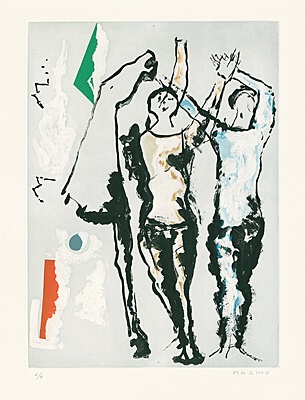
Marino Marini
(Pistoia 1901 - 1980 Viareggio)
"Triade"
(Triade)
Suite mit 3 Farbaquatintaradierungen 1976-1978
73,7 x 57,5 cm
sign. num.
Auflage 125 Exemplare
Guastalla A 195 - A 197
[17573]
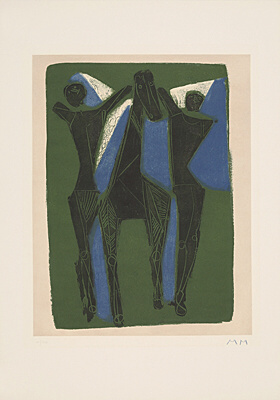
Marino Marini
(Pistoia 1901 - 1980 Viareggio)
aus "Marino from Goethe"
in Blau, Schwarz, Weiß und Grün
Farbaquatintaradierung 1979, verlegt 1980
90 x 62,8 cm, Pr. 63 x 49 cm
sign. num.
Auflage 195 Exemplare
Guastalla A 227 pl. III
[23335]
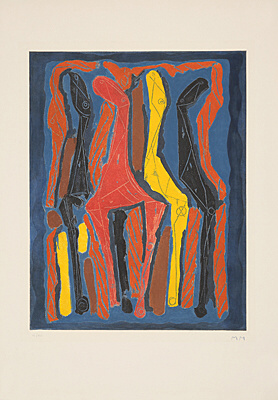
Marino Marini
(Pistoia 1901 - 1980 Viareggio)
aus "Marino from Goethe"
in Blau, Rot, Gelb, Orange, Braun, Schwarz
Farbaquatintaradierung 1979, verlegt 1980
90,3 x 62,8 cm, Pr. 63,5 x 49,5 cm
sign. num.
Auflage 195 Exemplare
Guastalla A 228 pl. IV (383)
[23334]
| 1901 | Marino Marini was born on February 27 in Pistoia, in Tuscany. His twin sister, Egle, became a poet. "For me Tuscany is a starting point, which is innate and is part of my being. My discovery of Etruscan art was an extraordinary event. This is why my art lies on themes from the past, as the link between man and horse, rather than on modern subjects like the man/machine relationship." |
| 1917 | He registers at the Accademia di Belle Arti of Florence where he participates in a drawing class given by Galileo Chini: "I looked for the origins of every idea in colour," he once said, "whether it’s called painting or drawing, I’m not sure." |
| 1919 | He makes his first trip to Paris where he encounters the new art trends. |
| 1920 | He is interested in painting and engraving. In some works from this period — the Virgins (Museo Marino Marini, Florence) — the influence of Piero della Francesca’s painting is evident. |
| 1922 | He concentrates his efforts on sculpture; the ancient art of Pistoia and Tuscany makes a decided impact on his development. |
| 1923 | He begins the long series of exhibitions. He participates in the Rome Biennial and in a group exhibition in Livorno. |
| 1926 | He takes a studio in Florence at the base of the hill of Fiesole. |
| 1927 | He takes part in the Third International Exhibition of Decorative Arts at Monza with several pieces. |
| 1928 | He participates in the Venice Biennial for the first time with two bronzes and takes part in the exhibition of the "Gruppo del Novecento Italiano" at the Milano Gallery with ten works including a few terracottas. The Blind Man is one of his first significant works. |
| 1929 | In this year he leaves Florence for Milan: "Milan is the Italian city that is most closely tied to Europe. It has the same colour as Europe, the same way of life, the same way of working. For me, to be in Milan is to live in the heart of Europe." He is called to Monza’s Villa Reale art school by Arturo Martini, whom he succeeded at the teaching chair of sculpture which he holds until 1940. He exhibits with other Italian artists, including Carrà, De Chirico, Sironi, Modigliani, and Martini, at the Fine Arts Society in Nice and at the Buonaparte publishing house in Paris. At the second exhibition of the Novecento Italiano at the Palazzo della Permanente in Milan, he presents six works. His terracotta sculpture, the People, is a revelation to the critics. That same year he makes the portrait of the painter Alberto Magnelli as well as a first self-portrait in polychrome plaster. |
| 1930 | He stays in Paris where he finds many friends such as Campigli, De Chirico, and Severini, and he meets Picasso, Maillol, Braque, Laurens and Lipchitz. He takes part in an exhibition in Florence with eight paintings and nine sculptures and in the Venice Biennial with three sculptures and one painting. He creates Ersilia, a wood sculpture that marks an important stage in his creative development. |
| 1931 | Another stay in Paris where he meets Tanguy, De Chirico, Kandinsky and Gonzàlez. |
| 1932 | The year of official recognition: he exhibits drawings and sculptures, first in Milan and then in Rome. He becomes an honorary member of the Accademia di Belle Arti in Florence. |
| 1934 | During a trip to Germany he visits the Bamberg Cathedral where he has a chance to admire the equestrian statue of Henry II (13th century). This "gothic" rider makes a deep impression on him and leads to the creation of the sculpture Idea for a Rider. |
| 1935 | He participates in the second Rome Quadrennial where he wins first prize. His sources, Etruscan and Roman art, are very evident here. He makes a second self-portrait in bronze and begins the theme of the Pomonas, the Etruscan goddess symbolizing the fertility of the earth. |
| 1936 | The first monography about him is published by Editions him is published by Editions des Chroniques du Jour (Paris), including an introduction by Paul Fierens. He participates in the twentieth Venice Biennial with nine works. He begins the Riders series during this period. |
| 1937 | He makes several trips to ltaly and Europe. During a new trip to Paris he enjoys the company of many artists: Kandinsky, Tanguy, Maillol, Picasso, Braque, Laurens, Magnelli, De Chirico... He wins the Grand Prix at the International Exhibition in Paris. A wood sculpture, the Boxer, of 1935 enters French collections. |
| 1938 | On December 14 he marries Mercedes Pedrazzini whom he calls Marina as though to underline their close ties that would unite them through-out their lives. He participates in the Venice Biennial with two portraits. |
| 1939 | He takes part in the third Rome Quadrennial with five works and exhibits in December at the Barbaroux Gallery in Milan. |
| 1940 | He leaves his teaching position at Monza to become a professor in the sculpture department at the Accademia in Turin. |
| 1941 | Marini earns the teaching chair for sculpture at the Accademia di Brera in Milan. |
| 1942 | He makes his third self-portrait in polychrome plaster. In November he exhibits a selection of drawings at the Zodiaco Gallery in Rome. His studio in Monza and his apartment in Milan are destroyed by bombing as are quite a few of his works. In December, he and his wife seek refuge at Tenero, near Locarno in Switzerland, where he continues to work. |
| 1943 | He makes frequent trips to Zurich and Basel. Here he finds many artists including Giacometti, Banninger, Wotruba, Germaine Richier, and Haller. He moves closer to lithogaphy and sculpts the Pomonas, a portrait in bronze of Marina, and the famous Arcangelo (Arch.angel) that marks the inception of a series of Miracles. "The figure of the Archangel" Marino later says, "[...] greatly interested me in terms of physiognomy and even for the attitude of the body: its sadness expressed itself all over the face and body, a mournful construction, a sacrificial construction, a bountiful construction; this is why the body and not just the face interested me." |
| 1944 | He participated in the great Exhibition at the Kunstmuseum in Basel along with Wotruba and Germaine Richier. |
| 1945 | He exhibits once again with Wotruba and Germaine Richier at the Kunsthalle in Bern, and then in Zurich. He makes the bronze portrait of Germaine Richier and those in polychrome terracotta of Manuel and Ulrich Gasser that would be donated to Zurich’s Kunsthaus thirty years later. |
| 1948 | They return to Milan where Marino goes back to teaching at Brera. He settles into an atelier in Piazza Mirabello where he works for the rest of his life. He makes a portrait of Carrà and one of Marina in polychrome stucco. lt is a decisive year for the artist who makes several journeys and participates in the Venice Biennial where he has an entire room to himself. He meets Henry Moore and a deep friendship binds them. He meets the most important art dealer of the period — Curt Valentin — who falls in love with his works, so much so that he acquires many of them and becomes his agent in the United States, where he organizes many exhibitions. What’s more he meets Peggy Guggenheim who buys a bronze model of the The Town’s Guardian Angel, placing it in front of her homonymous museum on Venice’s Grand Canal. From this year on, his painterly production increases considerably. |
| 1949 | He takes part in the exhibition "Twentieth Century Italian Art" organized by Luigi Toninelli at the Museum of Modem Art in New York. This is the year in which he executes one of his major works The Town’s Guardian Angel which he wouid speak of many years later: "The gentle expression of the Guggenheim’s Rider is joyous... the war had just barely ended and the man on the horse, arms spread open, made you imagine that he could cry out what he was..." |
| 1950 | In his gallery, the Bulcholz Gallery, Curt Valentin organizes the first Marini exhibition in New York with drawings, lithographs and 28 sculptures. It runs from February 14 to March 11. The artist stays in the United States form February to June. He meets Stravinsky during this period and immediately does his portrait (a second version would be executed in 1951); he also meets Arp, Beckmann, Feininger, Dalí, and Mies van der Rohe. Kaufmann, the owner of Bear Run House, one of Frank Lloyd Wright’s masterpieces, purchases an example of The Town’s Guardian Angel and places it near the waterfall close to his house. Back from the United States, Marino stops in London where he visits Henry Moore. The Hanover Gallery holds an exhibition dedicated to him. |
| 1952 | He receives the international Grand Prize of Sculpture at the Venice Biennial. Again he has an exhibition room to himself where he displays twelve sculptures and six paintings. He works on six lithographs in Paris in the atelier of Fernand Mourlot. He meets Masson, Braque, Ungaretti, and Brancusi. The Miracles completely absorb him, but he continues the series of portraits, including the bronze one of Curt Valentin (a second version would be realized in 1954). |
| 1953 | Many exhibitions take place throughout Europe: in Göteborg, Stockholm, Copenhagen and Oslo. The same happens in the United States: in Cincinatti and in New York at Curt Valentin’s Gallery, then at the Museum of Modern Art where he takes part in the exhibition "Sculpture in the Twentieth Century". The monography edited by Umbro Apollonio is published. |
| 1954 | He wins the Grand Prize from the Lincei Academy in Rome. During the summer he and his wife move into the house she designed, the Germinaia at Forte dei Marmi. This is where Curt Valentin dies. This was a great loss for the artist who admired him and had great esteem for him. Pierre Matisse becomes Marini’s new dealer in the United States. Pablo Neruda meets Marino at the Germinaia. |
| 1955 | Personal exhibitions in Germany, France (exhibition of lithographies at the Berggruen Gallery in Paris), Holland, and the United States (New York). He participates in Kassel’s Documenta. |
| 1956 | Personal exhibitions in London and Los Angeles. He takes part in the international Exhibition at the Rodin Museum in Paris. Marino confronts the new theme of the Warrior. |
| 1957 | Personal exhibitions in Dusseldorf and New York. |
| 1958 | He exhibits some works together with those of Giacometti, Matisse, and Moore at the Hanover Galiery in London. The Bayerische Staatsgemaldesammlung in Munich purchases a large Miracle. |
| 1959 | He makes an equestrian monument in bronze for a square in The Hague in memory of the horror of the war. lt is the largest work in bronze made by the artist (6 metres high). The base bears the inscription: "We built, we destroyed, and a sad song weighed on the world." He participates in Kassel’s Documenta. |
| 1960 | The Germanisches Nationalmuseum in Nuremberg purchases a large Warrior. The large Miracle of 1953 is piaced in Rotterdam in memory of those who fell at war. |
| 1961 | He executes a portrait of Henry Miller at Forte dei Marmi, where he also did Henry Moore’s. |
| 1962 | Zurich’s Kunsthaus presents a major retrospective reuniting more than two hundred works and meets with great success. He makes the portrait of Marc Chagall and Henry Moore. Moore donates his to the National Portrait Gallery in London. |
| 1963 | He presents a few paintings at the Toninelli Gallery in Milan and a few sculptures at the Calder — Marini Exhibition at the Gallery of Modern Art in Basel. In Arp’s atelier, he makes the artist’s portrait. Franco Russoli’s monography is published. |
| 1964 | A major painting exhibition at the Museum Boymans Van Beuningen in Rotterdam. He participates in Kassel’s Documenta. |
| 1966 | An important exhibition of sculpture, paintings, and drawings at Palazzo Venezia in Rome, curated by Giovanni Carandente. |
| 1967 | He goes to Berlin to meet with Mies van der Rohe, who is supervising the construction of the Nationalgalerie, and makes a portrait of him that was commissioned by the museum itself. |
| 1968 | He receives the highest German honour at Gottingen: membership in the Orden Pour le mérite of science and art. Marino is very proud of this honour which had previously been conceded to only two great ltalians: Alessandro Manzoni and Giuseppe Verdi. He works mostly in stone, but painting remains one of his greatest interests: "I have always had the need to paint and I never begin a sculpture before first investigating its essence pictorially... To conceive of a form is to recognize the colour, it is the vision of colour, to paint is to enter the poetry of the fact and the fact becomes reality through the act." |
| 1969 | Exhibition "From Colour to Form" at the Bibliothèque Nationale in Paris. |
| 1971 | Creation of the Idea for the Miracle. |
| 1972 | He becomes an honorary citizen of the City of Milan. In this year a retrospective of his works, dedicated to "Twentieth Century Personalities", is held at the Piero della Francesca research centre. Marino and Marina donate an important collection of works, sculptures (above all portraits), paintings, and drawings. |
| 1973 | The inauguration of the Museo Marino Marini within the Galleria d’Arie Moderna in Milan. At the request of the director of La Scala, Paolo Grassi, he creates the decoration and costumes for Stravinsky’s The Rite of Spring. |
| 1974 | Two large sculptures are donated to the Musei Vaticani in Rome: a Miracle in stone, donated by Gianni Agnelli, and a Rider in polychrome wood from the Battiato Collection. |
| 1975 | Exhibition at the Castello Sforzesco in Milan of twenty-one paintings from his early years. |
| 1976 | Munich’s Staatsgalerie Moderner Kunst dedicates a permanent exhibition space for paintings and sculpture to him. A retrospective of his graphic works is presented in Bavarian state museums, and then in Turin and Paris. |
| 1977 | He completes his last sculpture, a portrait of Oskar Kokoschka which he began in 1976. |
| 1978 | An itinerant exhibition of sculpture and painting in Japan’s museums in Tokyo, Yamagata, Sapporo, Kobe, and Kumamoto. In the same year he gives a bronze Rider to the Museum of Modem Art in Paris. |
| 1979 | lnauguration at the Pistoia’s Town Hall of a Documentation Centre dedicated to Marino Marini’s works; it has a library, a photographic library, a video library, and many sculptures including a large Miracle. |
| 1980 | He dies on August 6 in Viareggio at age seventy-nine. |
| 1988 | Florence’s Museo Marino Marini opens in the ancient church of San Pancrazio. Part of the sculptural and pictorial works donated to the museum come from the Marina Marini Collection. |
| 1990 | At the Vatican, in the Borgia’s apartments, inauguration of the Sala delle Arti Liberali, following a considerable donation by Marina Marini. |
| 1990 | The Fondazione Marino Marini at the Palazzo del Tau opens in Pistoia and is destined to ensure the conservation and propagation of his work. |
Kaum ein Künstler der modernen Kunst ist so eng mit dem Thema "Pferd und Reiter" verbunden wie der international arrivierte, 1901 in Pistoia geborene und 1980 in Viareggio verstorbene, italienische Bildhauer, Maler und Graphiker Marino Marini.
In der Konstellation Pferd und Mensch findet der Künstler den Ausdruck für Mythos und Wirklichkeit, Schönheit und Verderben, Tapferkeit und menschliches Versagen. Nach den Erfahrungen des Krieges wird es zum Leitbild seiner tragischen Weltsicht: Die unruhigen, sich aufbäumenden Tiere mit ihren stürzenden Reitern sind Marinis Symbol für die Existenzbefragung der Menschlichkeit.
In seinen Arbeiten auf Papier und in seinem druckgraphischen Werk verzichtet der Bildhauer auf jegliche Evozierung von Dreidimensionalität. Die Formen bizarrer Silhouetten von Mensch und Tier sind in ihrer Zweidimensionalität gebunden und auf wenige Linien und Flächen reduziert. Doch in dem genialen Zusammenspiel von Expressivität, Abstraktion und kühner und dennoch ausgewogener Komposition von Form und Farbe entfalten sich eine beeindruckende Dynamik und Ausdruckskraft.